A meta-analysis of the impacts of forest logging on soil CO2 efflux
LongFei Chen ,YangZhou Xiang ,ZhiBin He ,Jun Du ,PengFei Lin ,Xi Zhu
1.Linze Inland River Basin Research Station,Chinese Ecosystem Research Network,Key Laboratory of Eco-hydrology of Inland River Basin,Northwest Institute of Eco-Environment and Resources,Chinese Academy of Sciences,Lanzhou,Gansu 730000,China
2.School of Geography and Resources,Guizhou Education University,Guiyang,Guizhou 550018,China
ABSTRACT Soil CO2 efflux,the second largest flux in a forest carbon budget,plays an important role in global carbon cycling.Forest logging is expected to have large effects on soil CO2 efflux and carbon sequestration in forest ecosystems.However,a comprehensive understanding of soil CO2 efflux dynamics in response to forest logging remains elusive due to large vari‐ability in results obtained across individual studies.Here,we used a meta-analysis approach to synthesize the results of 77 individual field studies to determine the impacts of forest logging on soil CO2 efflux.Our results reveal that forest log‐ging significantly stimulated soil CO2 efflux of the growing season by 5.02%.However,averaged across all studies,nonsignificant effect was detected following forest logging.The large variation among forest logging impacts was best ex‐plained by forest type,logging type,and time since logging.Soil CO2 efflux in coniferous forests exhibited a significant increase(4.38%)due to forest logging,while mixed and hardwood forests showed no significant change.Logging type also had a significant effect on soil CO2 efflux,with thinning increasing soil CO2 efflux by 12.05%,while clear-cutting decreasing soil CO2 efflux by 8.63%.The time since logging also had variable effects,with higher soil CO2 efflux for 2 years after logging,and lower for 3-6 years after logging;when exceeded 6 years,soil CO2 efflux increased.As signifi‐cantly negative impacts of forest logging were detected on fine root biomass,the general positive effects on soil CO2 efflux can be explained by the accelerated decomposition of organic matter as a result of elevated soil temperature and organic substrate quality.Our results demonstrate that forest logging had potentially negative effects on carbon sequestration in forest ecosystems.
Keywords:soil respiration;forest ecosystem;thinning;clear-cutting;time since logging
1 Introduction
Soil CO2efflux(soil respiration)contributes 30%−80%of total forest ecosystem respiration(Schlesinger and Andrews,2000;Janssens et al.,2001),and small changes in forest soil CO2efflux could have major im‐pacts on the forest C budget,and alter CO2concentra‐tions in the atmosphere(Bond-Lamberty and Thom‐son,2010).Efflux of CO2from the soil surface is pri‐marily due to autotrophic respiration by fine roots and mycorrhizae(Boone et al.,1998;Bond-Lamberty et al., 2004), and heterotrophic respiration associated with microbial decomposition of soil organic matter(Buchmann,2000;Olajuyigbe et al.,2012).Forest logging,the cutting of trees for wood procurement,wildfire-risk reduction,and improvements to tree pro‐ductivity(Tian et al.,2009;Martín-Benito et al.,2010;Zhou et al.,2013),is a common silvicultural strategy in forest ecosystems.Stand responses following log‐ging involve modifications in moisture and tempera‐ture at ground level(Cheng et al.,2014;Chase et al.,2016;He et al.,2018),litter production and quality(Thomas et al.,1999;Dodson et al.,2008),root dy‐namics(Tufekcioglu et al.,2005;Pang et al.,2016),and soil microbial activity(Chatterjee et al.,2008;Baena et al.,2013).Alterations in biophysical factors following logging are expected to have large effects on soil CO2efflux and C sequestration in forest eco‐systems(Nave et al.,2010;Shabaga et al.,2015;He et al.,2018).
Currently,numerous studies have been conducted to investigate the impacts of forest logging on soil CO2efflux(e.g.,Tian et al.,2009;Cheng et al.,2014;Shabaga et al.,2015).However,experimental results obtained with individual studies are highly variable,not only in terms of magnitude but also in the direc‐tion of effect(Ma et al.,2004;Tang et al.,2005;Guo et al.,2010).Such discrepancies may be due to the differences in forest type(Guo et al.,2010),logging type and intensity(Laporte et al.,2003;Cheng et al.,2014),time since logging(Peng and Thomas et al.,2006;Tian et al.,2009),and site conditions(Panosso et al.,2011).For example,thinning in an old-growth conifer forest in California resulted in a significant in‐crease in soil CO2efflux(Ma et al.,2004);similar trends were observed in a northern mixed deciduous forest of Central Ontario(Shabaga et al.,2015),and a beech forest ecosystem of Hesse(Epron et al.,2004).However,no clear trends were observed in soil respi‐ration in a ponderosa pine plantation after thinning in the Sierra Nevada Mountains(Tang et al.,2005).Guo et al.(2010)documented that soil CO2efflux was re‐duced after clear-cutting in both Chinese fir and ever‐green broadleaved forests in mid-subtropical China.In addition,soil CO2efflux has been reported to in‐crease initially after forest logging,decrease within a few years,and then gradually increase again(Peng and Thomas,2006;Tian et al.,2009).The inconsisten‐cy of results from different studies indicates that the dynamics of soil CO2efflux following forest logging have high levels of spatial and temporal variability(Tian et al.,2009;Guo et al.,2010;Pang et al.,2016),and that the uncertainty is unlikely to be resolved by studies performed at individual sites.Rather,it is nec‐essary to integrate results across individual studies to estimate a central tendency,and distinguish between underlying patterns of changes in soil C emissions in‐duced by logging.
So far,several meta-analyses have been conduct‐ed to examine changes in forest structural characteris‐tics(Zhou et al.,2013),soil carbon(C)storage(John‐son and Curtis,2001;Nave et al.,2010;Zhou et al.,2013),and soil nitrogen(N)dynamics(Jerabkova et al.,2011)after logging in forest ecosystems.Howev‐er,a comprehensive assessment of the impacts of for‐est logging on soil CO2efflux is lacking despite many observations conducted at local levels.In this study,we used a meta-analysis approach to synthesize 192 observations from 77 individual field studies that re‐ported soil CO2efflux dynamics in response to forest logging.Our main objectives were to quantify the re‐sponses of soil CO2efflux to forest logging,explore possible causes(e.g.,forest type,logging type and in‐tensity,and time since logging)of response variabili‐ty,and to investigate the relationships between soil CO2efflux and biophysical factors.
2 Methods
2.1 Data collection
Data were obtained from 77 relevant scientific pa‐pers published during 1980 −2018(Table S1).We searched online references with the Web of Science,Google Scholar,and China Academic Journal Net‐work Publishing Database(CNJD)using the follow‐ing search-term combinations:(forest logging/harvest/thinning/cutting/clear cutting/selective cutting) and(soil respiration/CO2/carbon emission)and their equiv‐alents in Chinese.Studies were selected based on the following considerations:(1)studies incorporated a reference treatment(i.e.,an unharvested forest plot),(2)only field-based experiments conducted in forest ecosystems were included, while modeling studies were excluded(Zhou et al.,2013;Deng et al.,2018),(3)papers dealing with repeated cutting were exclud‐ed,(4)the duration of soil CO2efflux measurements lasting longer than one growing season,and soil CO2efflux values measured annually or as the mean of growing or wet seasons were denoted differently(Zhong et al.,2016;Feng et al.,2017),and(5)the means,standard deviations/errors,and sample sizes of variables in the control and treatment groups were accessible directly from text, tables, or digitized graphs.
Raw data were either extracted from published ta‐bles or obtained by digitizing published graphs using GetData Graph Digitizer 2.24(free software down‐loaded from http://getdata-graph-digitizer.com).The reported soil CO2efflux,Q10,soil temperature,soil moisture,litter production(LP),fine root biomass(FRB),and associated soil properties(e.g.,soil organ‐ic carbon(SOC),total nitrogen(TN),soil pH,soil C:N ratios,and soil microbial biomass carbon(MBC))in the control and treatment groups were recorded.Relevant experimental information was also reported,including geographic location (longitude and lati‐tude),climatic factor(mean annual temperature and mean annual precipitation),forest type(coniferous,hardwood,and mixed),logging type(clear-cutting or thinning(including thinning from above and from be‐low)),time since logging,and thinning intensity(de‐fined by stem number,stand basal area,or volume)(Zhou et al.,2013).
2.2 Analysis
The response of soil CO2efflux and associated soil variables to forest logging was evaluated using the meta-analysis methods described by Hedges et al.(1999)and Luo et al.(2006).The meta-analysis was performed using the meta-analytical software MetaWin 2.1(Sinauer Associates Sunderland,MA,USA).The response ratio(RR)was used to estimate the magni‐tude of the effect for each individual observation.The RR was calculated as:

where Xt and Xc were mean values of the logging and control groups,respectively.
The corresponding sampling variance(v)was esti‐mated by:

where nt,nc,Dt and Dc were sample sizes and stan‐dard deviations for the logging and control groups,re‐spectively.
In this meta-analysis,the weighted response ratio(RR++)was calculated from RRij of individual pair‐wise comparison between logging and control groups with the following equations:
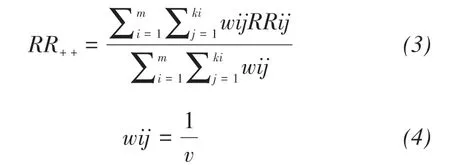
with the standard error as:

where wij is the weighting factor,m is the number of groups in given categories(e.g.,different logging types or forest types),ki is the number of comparisons in the ith group.To test whether experimental conditions altered the magnitude of soil CO2efflux after forest logging,we categorized the response ratios according to forest type,logging type and intensity,and time since logging(Table S2)based on previous studies(Tian et al.,2009;Nave et al.,2010;Zhou et al.,2013).
The 95%confidence interval(CI)for the log re‐sponse ratio was calculated by:

If the 95%CI values of RR++for a variable did not include zero,the effects of forest logging were consid‐ered to differ significantly between logging and con‐trol treatment.Otherwise,they were not considered to differ significantly.We also used a t-test to examine whether the RR++of a variable differed significantly between logging and control treatment.The frequency distributions of RR were assumed to follow normal distributions,and were fitted using a Gaussian func‐tion(Luo et al.,2006;Xu et al.,2013).
The percent change in a variable was calculated by:

In addition,ordinary least squares(OLS)regres‐sion was performed to evaluate the relationships be‐tween the RRs of soil CO2efflux and biophysical fac‐tors.As some of the studies did not report the stan‐dard error/deviation of Q10,the quoted RR used is the mean value of each RR in the study(Zhong et al.,2016;Deng et al.,2018).
3 Results
3.1 Overall effects of forest logging on soil CO2efflux and primary sources of variation
Forest logging significantly stimulated soil CO2efflux of the growing season by 5.02%.Averaged across all studies,non-significant effect was detected following forest logging(Figure 1).The responses of soil CO2efflux to forest logging varied with forest types.Specifically,forest logging did not significantly affect soil CO2efflux in mixed(2.21%,P>0.05)and hardwood forests(−1.02%,P>0.05),while conifer‐ous forests exhibited a significant increase(4.38%,P<0.05)(Figure 1).In addition,our results reveal that the mean RR of Q10was negative(RR=−0.08)across all studies,and the mean RR of hardwood and conifer‐ous forests was −0.13 and −0.06,respectively(Figure 1).
When grouped by logging type,clear-cutting signif‐icantly decreased soil CO2efflux by 8.63%(P<0.05),while thinning significantly enhanced soil CO2ef‐flux by 12.05%(P<0.05)(Figure 2).Soil CO2efflux increased more in medium thinning intensity(30%−50%)than in light thinning intensity(<30%)and high thinning intensity(>50%)(P>0.05)(Figure 2).Fur‐ther,forest logging significantly stimulated soil CO2efflux by 9.74%for 2 years post treatment(P<0.05),and decreased soil CO2efflux by 5.65%3 −6 years post treatment(P<0.05);when the time since log‐ging exceeded 6 years,an increase of 7.89%was observed(Figure 2).
3.2 Relationships between the RRs of soil CO2 efflux and biophysical factors
We also analyzed responses to logging of soil temperature(ST),soil moisture(SM),soil organic C(SOC),soil total N(TN),soil pH,soil C:N ratios,soil microbial biomass carbon(MBC),litter produc‐tion(LP),and fine root biomass(FRB).Forest log‐ging significantly increased ST,SM,and soil pH by 8.97%,6.25%,and 1.64%,and significantly decreased soil C:N ratios,LP,and FRB by 4.53%,20.29%,and 23.44%,respectively(Figure 3;Table 1).Forest log‐ging did not induce significant changes in SOC,TN,or MBC(Figure 3).
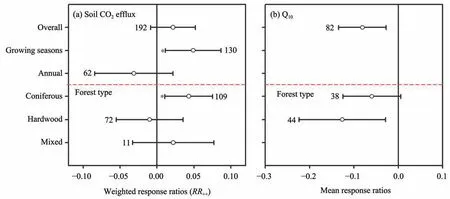
Figure 1 (a)weighted response ratio(RR++)of soil CO2 efflux to forest logging;(b)mean response ratios of Q10 to forest logging.Bars represent RR++and 95%confidence intervals(Cl).If the CI did not overlap with zero,the response was considered significant(*P<0.05,**P<0.01,***P<0.001).Vertical lines are drawn at RR=0.The sample size for each variable is shown next to the bar
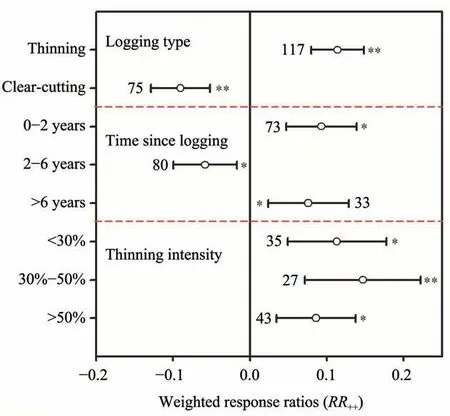
Figure 2 Weighted response ratio(RR++)of soil CO2 efflux categorized according to logging type,time since logging,and thinning intensity.Bars represent RR++and 95%confidence intervals(Cl).If the CI did not overlap with zero,the response was considered significant(*P<0.05,**P<0.01,***P<0.001).Vertical lines are drawn at RR=0.The sample size for each variable is shown next to the bar
The RRs of soil CO2efflux exhibited a significant parabolic relationship with the RRs of SM,signifi‐cantly positive relationships with the RRs of ST and FRB,and a significantly negative relationship with the RRs of soil C:N ratios(Figure 4).However,no sig‐nificant relationship was observed between the RRs of soil CO2efflux and the other biophysical factors.
4 Discussion
4.1 Responses of soil CO2 efflux to forest logging
To our knowledge,this study is the first compre‐hensive assessment of the impacts of forest logging on soil CO2efflux.Averaged across all studies,nonsignificant effect was detected following forest log‐ging.However,our meta-analysis revealed that forest logging significantly stimulated soil CO2efflux dur‐ing the growing season.Efflux of CO2from the soil surface is primarily due to autotrophic respiration con‐trolled by fine root biomass in a specific soil layer(Widén and Majdi,2001;Sulzman et al.,2005;Cheng et al.,2014),and heterotrophic respiration associated with microbial decomposition of soil organic matter(Boone et al.,1998;Buchmann,2000;Olajuyigbe et al.,2012).In the present study,forest logging signifi‐cantly reduced fine root biomass by an average of 23.44%(Table 1),and significant negative impacts of forest logging on fine root biomass were observed in most study sites(Figure S1).The decline in fine root biomass following forest logging is expected to result in a decrease in autotrophic respiration by roots(Pang et al.,2016).Thus,we attributed the general positive effects of forest logging on soil CO2efflux to the ac‐celerated decomposition of organic matter.In addi‐tion,negative influences of forest logging were detect‐ed on Q10values across the studies.The Q10values are important indicators of the sensitivity of soil CO2ef‐flux to elevated temperature(Olajuyigbe et al.,2012;Cheng et al.,2014).The decrease in Q10values sug‐gest that less CO2efflux may be expected from forest soils following logging under climate warming.
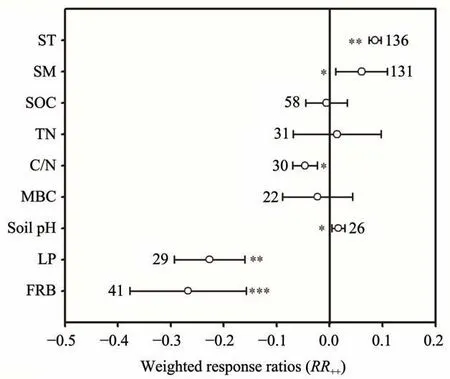
Figure 3 Weighted response ratio(RR++)of soil temperature,soil moisture,soil organic carbon,total nitrogen,soil C:N ratios,soil microbial biomass carbon,soil pH,litter production,and fine root biomass to forest logging.Bars represent RR++and 95%confidence intervals(Cl).If the CI did not overlap with zero,the response was considered significant(*P<0.05,**P<0.01,***P<0.001).Vertical lines are drawn at RR=0.The sample size for each variable is shown next to the bar(ST,soil temperature;SM,soil moisture;SOC,soil organic carbon;TN,total nitrogen;C/N,soil C:N ratios;MBC,soil microbial biomass carbon;LP,litter production;FRB,fine root biomass)
4.2 Primary sources of variation in soil CO2 efflux following forest logging
The lack of a strong response of soil CO2efflux to forest logging was revealed across the studies.Our meta-analysis identified several factors responsible for variation underlying this overall effect.The most significant categorical factors accounting for amongstudy variation in forest logging impacts were forest type,logging type,and recovery time.
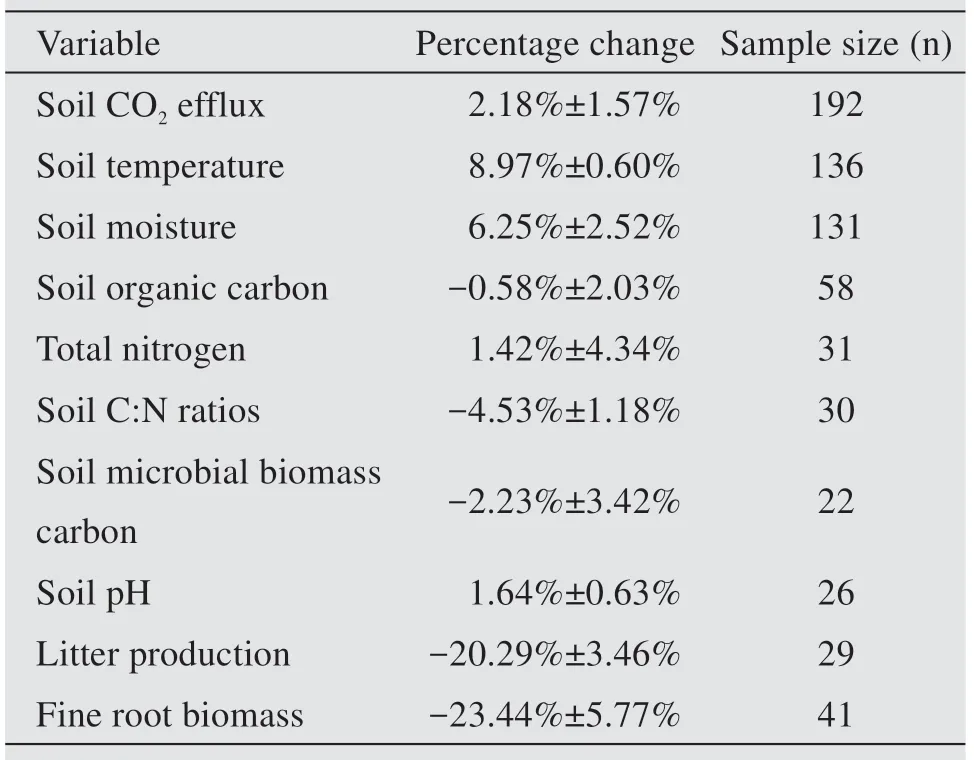
Table 1 Percentage changes of soil CO2 efflux,soil temperature,soil moisture,soil organic carbon,total nitrogen,soil C:N ratios,soil microbial biomass carbon,soil pH,litter production,and fine root biomass in response to forest logging
Experimental results of many individual studies show that forest logging impacts on soil CO2efflux varied among forest types(Ma et al.,2004;Guo et al.,2010;Shabaga et al.,2015).Our results support this general observation.In the present study,forest logging significantly stimulated soil CO2efflux in co‐niferous forests,while no significant effects were ob‐served in either mixed or hardwood forests(Figure 1).Generally,coniferous forests are found in regions at high latitudes and altitudes.Due to cold conditions and environmental constraints such as freezing,de‐composition proceeds much more slowly in conifer‐ous forests(Davidson and Janssens,2006),and organ‐ic matter tends to accumulate in coniferous forests more than in other forest types(Liu et al.,2017).Thus,the strong responses of soil CO2efflux to forest logging in coniferous forests may be attributed to the abundant substrate for accelerated microbial decom‐position induced by logging.
The impacts of forest logging on soil CO2efflux also differed significantly among logging types,with thinning increasing soil CO2efflux by 12.05%,while clear-cutting decreasing soil CO2efflux by 8.63%(Figure 2).Forest logging is expected to have nega‐tive impacts on soil CO2efflux because of the decline in root respiration(Peng and Thomas,2006;Pang et al.,2016).However,the increase in microbial respira‐tion due to an improvement in microclimate and sub‐strate availability induced by logging may compen‐sate for the decrease in root respiration,yielding quite different results(Toland and Zak,1994;Tang et al.,2005).Generally,thinning destroys less biomass than clear cutting,and has little effect on root density and activity,indicating that thinning tends to exert more positive effects on soil CO2efflux than clear-cutting.

Figure 4 Relationships between the response ratio of soil CO2 efflux and the response ratio of soil temperature,soil moisture,soil C:N ratios,and fine root biomass
In addition,following forest logging,soil CO2ef‐flux was significantly higher for a period of 2 years,significantly lower for subsequent 2−6 years,and when the time since logging exceeded 6 years,soil CO2ef‐flux increased again over the reference(Figure 2).These results suggest that time since logging also had significant impacts on the response of soil CO2efflux to forest logging.Large variations in forest logging impacts among different recovery times were also ob‐served in earlier individual studies(e.g.,Tian et al.,2009;Pang et al.,2016),and root death,decay,sub‐strate availability,and regrowth were largely responsi‐ble for the temporal patterns(Olajuyigbe et al.,2012;Cheng et al.,2014).Generally,an initial increase was observed following logging as a result of an increase in microbial respiration induced by changes in soil mi‐croclimate and a large pulse of harvest residues(Olajuyigbe et al.,2012).Subsequently,soil CO2ef‐flux has often been reported to exhibit a decrease due to the decline in tree root respiration and consumption of soil labile C(Peng and Thomas,2006;Zu et al.,2009).However,in the long term,the gradual re‐growth of understory vegetation and roots may offset or exceed the reduction in soil CO2efflux induced by logging,resulting in positive effects again(Tian et al.,2009;Pang et al.,2016).
4.3 Factors influencing the responses of soil CO2 efflux to forest logging
The effects of forest logging on soil respiration are complex,and determined by many interactive fac‐tors including microclimatic conditions,soil proper‐ties,and fine root dynamics(Tang et al.,2005;Selig et al.,2008;Pang et al.,2013;Cheng et al.,2014).Our synthesis indicate that microclimatic conditions(soil temperature and moisture),soil C:N,and fine root biomass were the major biophysical factors influ‐encing soil CO2efflux after forest logging,confirming previous understanding from individual studies.
Forest logging opens forest canopies and allows more solar and thermal radiation to penetrate to ground level(Chase et al.,2016).Thus,increased soil temperatures detected following forest logging were mainly attributed to canopy openness created by thin‐ning(Tufekcioglu et al.,2005;Baena et al.,2013).Higher soil temperatures induced by logging would provide favorable environmental conditions for soil organic matter decomposition and rhizospheric respi‐ration(Pang et al.,2016).In our synthesis,forest log‐ging increased soil temperatures,and the RRs of soil CO2efflux exhibited a significant positive relation‐ship with the dynamics of soil temperature following logging,suggesting that the elevated soil temperature contributed to an increase in soil CO2efflux.
Similarly,forest logging was also found to have a significant positive impact on soil moisture.Due to a decrease in evapotranspiration and canopy intercep‐tion by the remaining biomass,soil moisture had been generally observed to increase following logging(Chase et al.,2016).Thus,the results of our synthesis confirmed previous outcomes(Kim,2008;Masyagina et al.,2010;Akburak and Makineci,2015).Moreover,our results reveal that the RRs of soil CO2efflux ex‐hibited a significant parabolic relationship with the dynamics of soil temperature under forest logging.A parabolic function has been widely adopted to de‐scribe the relationship between soil CO2efflux and soil moisture(Londo et al.,1999),and the mecha‐nisms were related to soil biological activity and sub‐strate availability (Davidson and Janssens, 2006;Cheng et al.,2014).Under conditions of lower soil moisture,the diffusion of extracellular enzymes and soluble organic-C substrates would be enhanced by the elevated soil moisture,resulting in an increase in soil CO2efflux(Mchale et al.,2005;Cheng et al.,2014). However, when soil moisture exceeded a threshold,soil CO2efflux was inhibited by increasing soil moisture due to a decline in aerobic decomposi‐tion and degradative enzymatic pathways(Davidson and Janssens,2006).
Soil C:N ratios indicate the quality of organic mat‐ter inputs into the soil and the degree of mineraliza‐tion(Johnson and Curtis,2001).Forest logging re‐duced litter production and altered the composition of understory vegetation,with expansion of species ex‐hibiting lower C:N ratios(such as herbs)(Kaye and Hart,1998;Kang et al.,2014;Muscolo et al.,2014).The decrease in soil C:N ratios detected following for‐est logging can be partially explained by modifica‐tions in the quality of organic inputs into the soil.In this synthesis,a significant negative relationship was detected between the RRs of soil CO2efflux and soil C:N ratios.Generally,substrates with lower C:N ra‐tios are more vulnerable to decomposition by soil mi‐crobes than are other substrates(Corbeels et al.,2003;Xu et al.,2008);thus,the improved substrate quality induced by forest logging may have also contributed to an increase in soil CO2efflux.Conversely,the ac‐celerated mineralization rates of soil organic matter would promote a decrease in soil C:N ratios.In addi‐tion,the results of our synthesis shows that the RRs of soil CO2efflux exhibited a significant positive rela‐tionship with the RRs of fine root biomass,confirm‐ing that the decline in fine roots caused by forest log‐ging would directly inhibit soil CO2efflux,consistent with previous understanding(Peng and Thomas,2006;Pang et al.,2016).
5 Conclusions
Generally,soil CO2efflux shows positive respons‐es to forest logging although numerous sources of variation mediated this overall effect,highlighting the negative influences of forest logging on C sequestra‐tion in forest ecosystems.The large variation among forest logging influences is best explained by forest type,logging type,and time since logging.Because a decline in fine root biomass following forest logging is expected to result in a decrease in autotrophic respi‐ration,the general positive influences of forest log‐ging on soil CO2efflux can be explained by the accel‐erated decomposition of organic matter in conditions of elevated soil temperature and substrate quality to some extent.This study is the first comprehensive as‐sessment of the influences of forest logging on soil CO2efflux.The results of our synthesis will provide important references for the management of forest C dynamics.
Acknowledgments:
This work was supported by the National Natural Sci‐ence Foundation of China(41701296;41801069),the Strategic Priority Research Program of the Chinese Academy of Sciences(XDA23060301)and the CAS"Light of West China"Program(29Y829861).
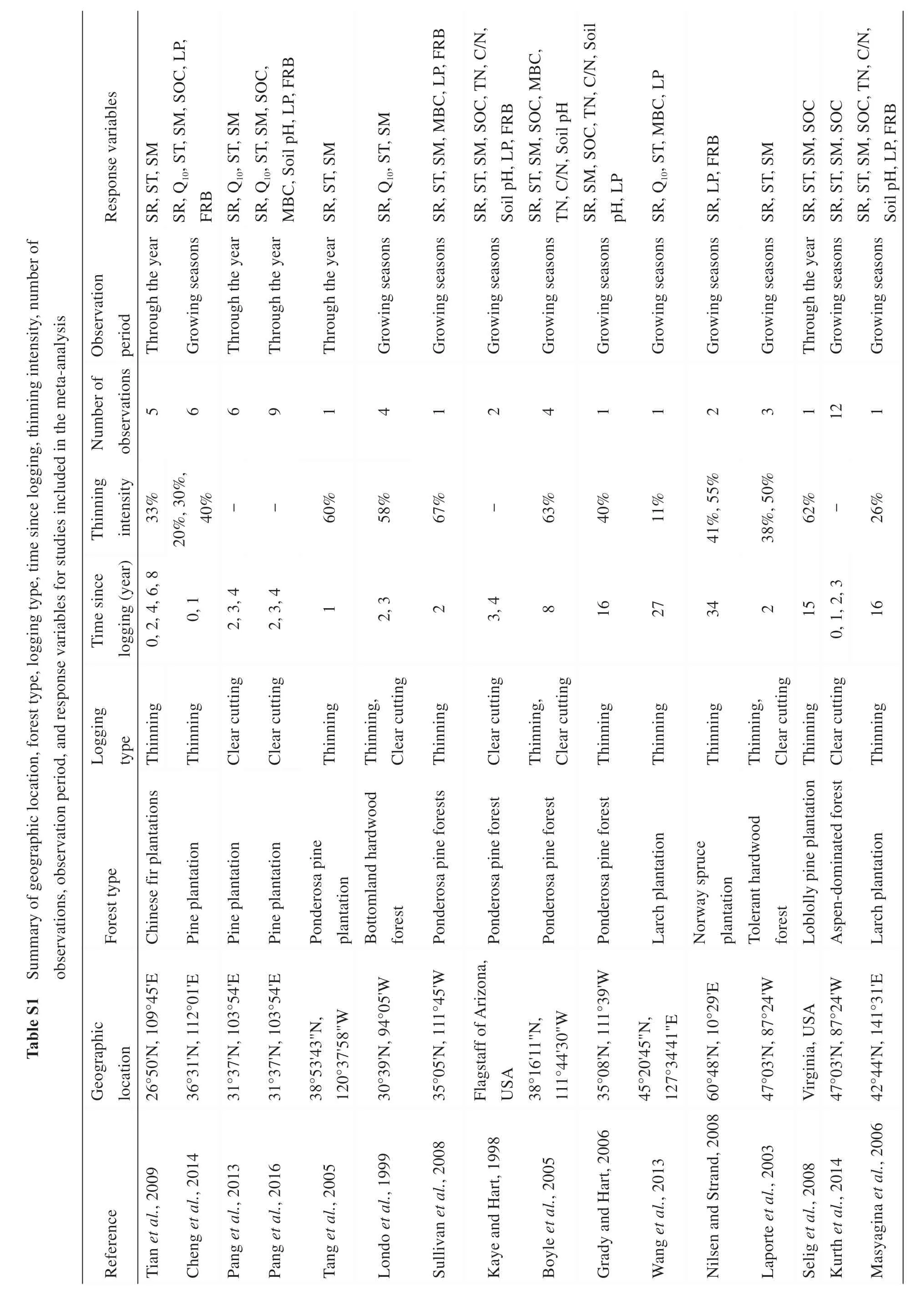
?

?
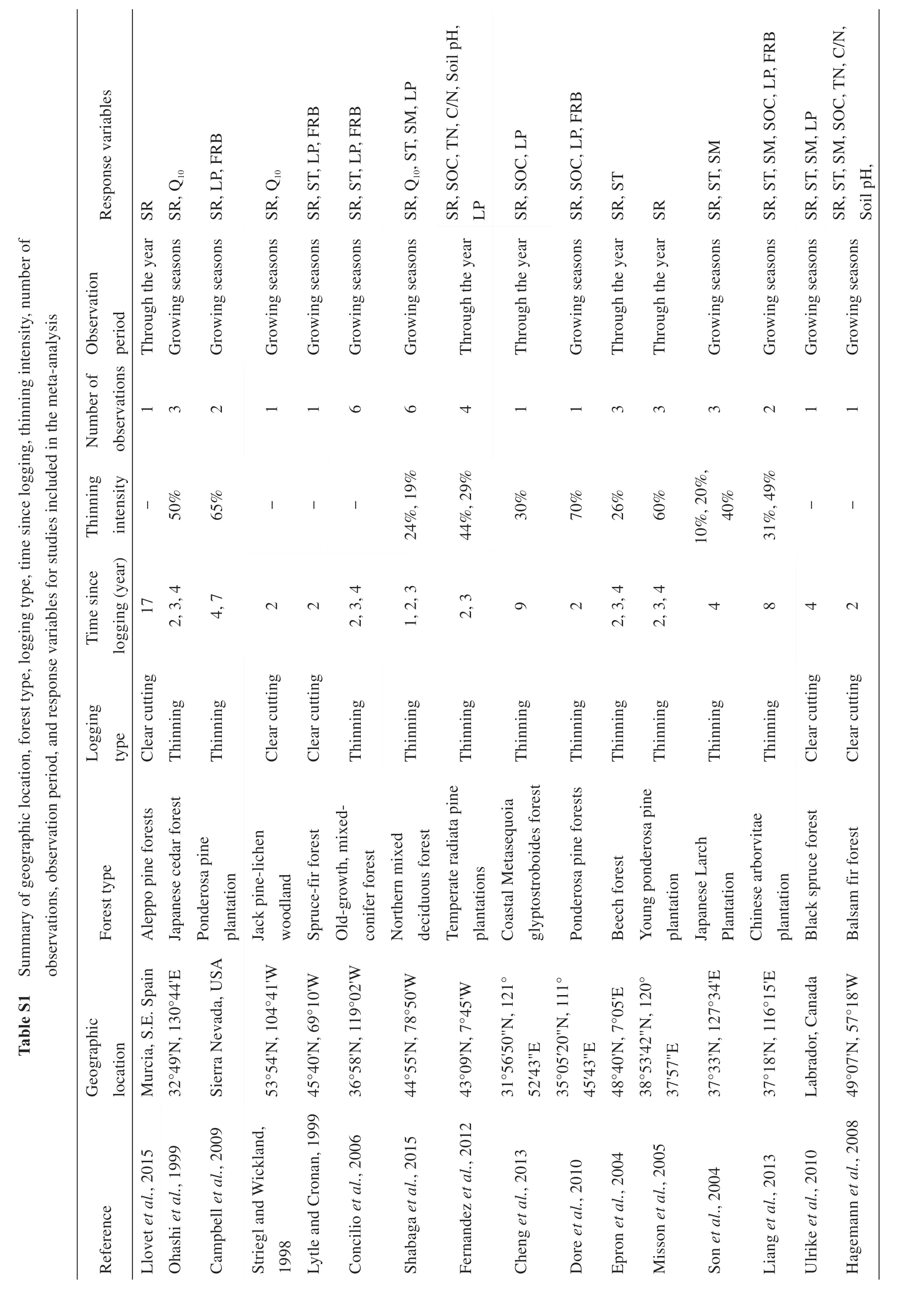
?
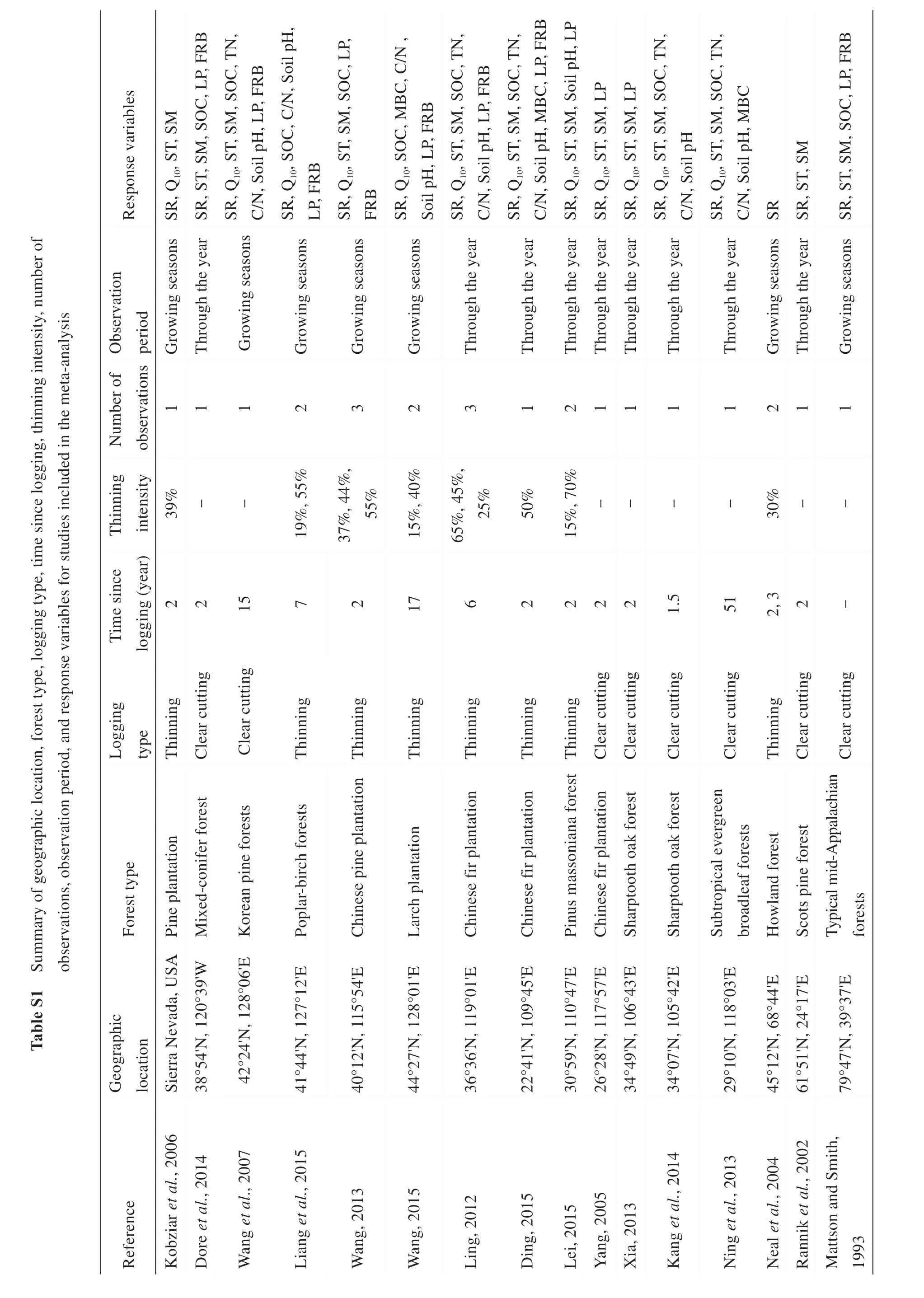
?
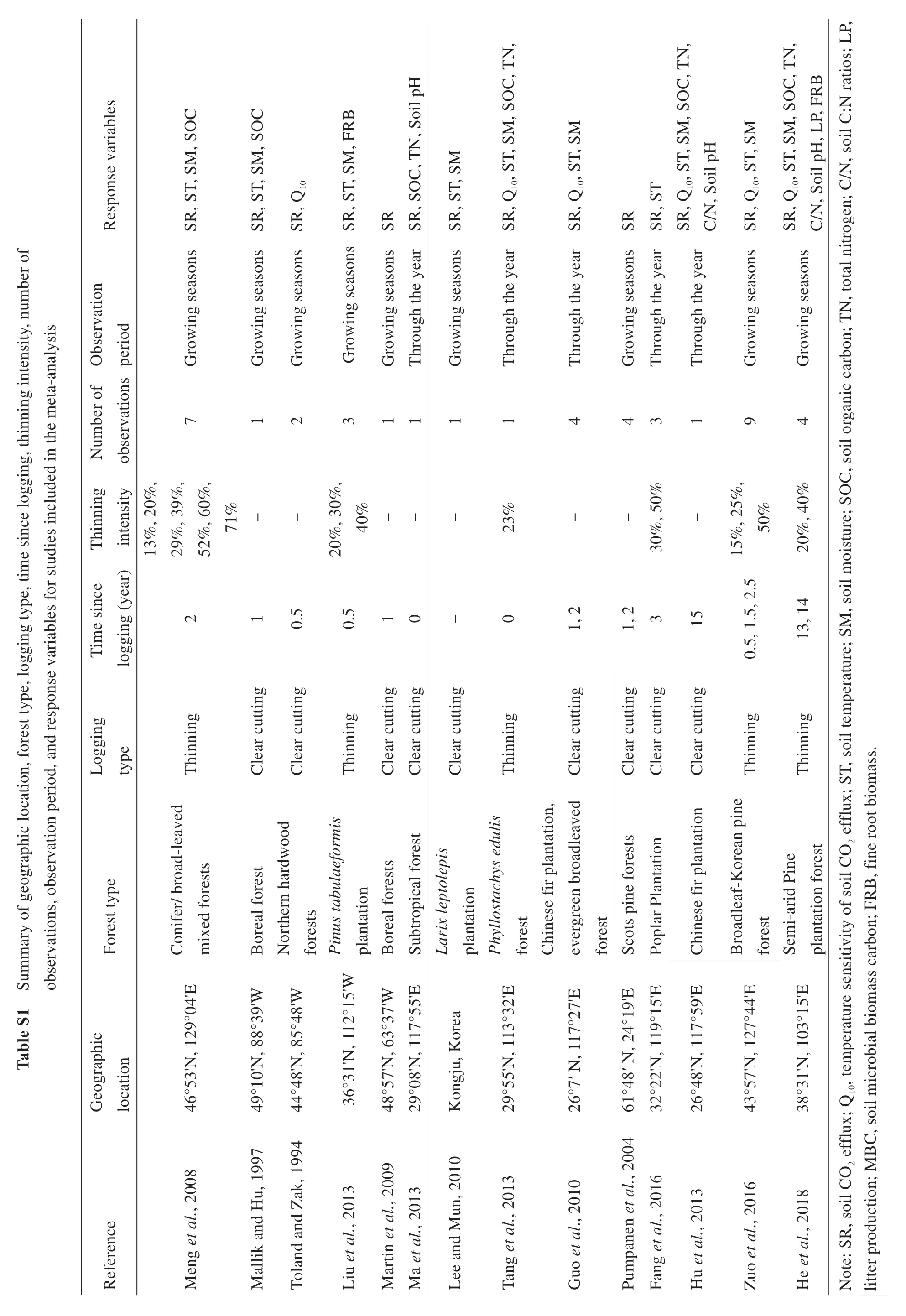
?

Table S2 Categorical factors tested as potential predictor variables in the meta-analysis.

Figure S1 Frequency distributions of response ratios(RR)of soil CO2 efflux(a),soil temperature(b),soil moisture(c),soil organic carbon(d),total nitrogen(e),soil microbial biomass carbon(f),soil C:N ratios(g),soil pH(h),litter production(i),and fine root biomass(j)
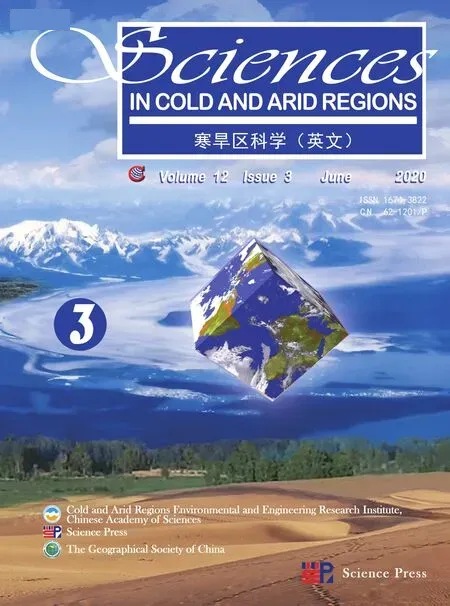 Sciences in Cold and Arid Regions2020年3期
Sciences in Cold and Arid Regions2020年3期
- Sciences in Cold and Arid Regions的其它文章
- A modified numerical model for moisture-salt transport in unsaturated sandy soil under evaporation
- Editors-in-Chief Yuanming Lai and Ximing Cai
- Numerical simulations on cutting of frozen soil using HJC Model
- Mapping the dynamic degree of aeolian desertification in the Shiyang River Basin from 1975 to 2010
- Quantitatively estimate the components of natural runoff and identify the impacting factors in a snow-fed river basin of China
- Fast genetic mapping in barley:case studies of cuticle mutants using RNA-sequencing
